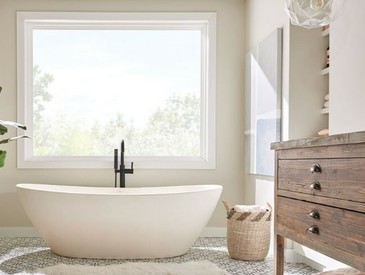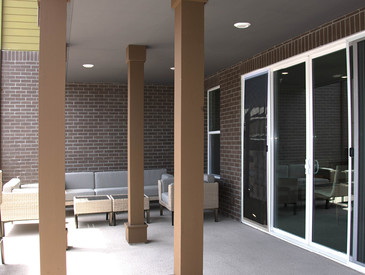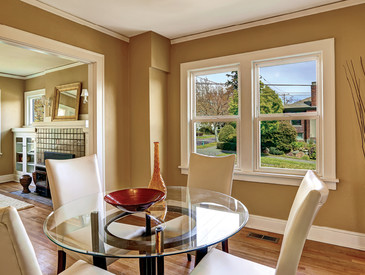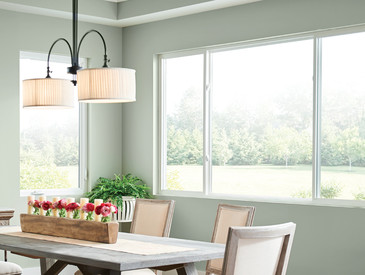When it comes to home renovation or construction, understanding window sizes can save you a lot of time and hassle. Standard window sizes refer to common dimensions manufacturers adhere to, making it easier for homeowners and contractors to find replacements or new windows without needing custom work. These sizes vary based on the type of window but provide a starting point for planning your project.
What Are Standard Window Sizes?
Standard window sizes are predetermined dimensions that most window manufacturers use. These builder-grade windows will fit the rough openings (the gaps in your wall where the window and frame go) in most houses built within the last 50 years.
Knowing and using common window sizes facilitates easier, quicker, and often more cost-effective window installation. Whether you're replacing old windows or installing new ones in a construction project, it’s likely that your window measurements will fall into one of the following categories.
Horizontal Slider Window Sizes
Horizontal slider windows open by sliding horizontally along the window frame. They are ideal for spaces where you can't easily push a window out or up, like over a kitchen sink. They’re also popular for larger windows.
- Standard horizontal window widths: 36, 48, 60, 72, or 84 inches
- Standard horizontal window heights: 24, 36, 48, or 60 inches
Single Hung Window Sizes
Single hung windows have a bottom sash that moves vertically, while the upper sash remains stationary. They have many different standard window heights and widths, making them incredibly versatile and a classic choice for any home.
- Standard single hung window widths: 24, 28, 32, 40, 44, or 48 inches
- Standard single hung window heights: 36, 44, 48, 52, 54, 60, 62, or 72 inches
Double Hung Window Sizes
Double hung windows allow both the upper and lower sashes to move. They provide excellent ventilation and are easy to clean. Like single hung, they’re available in many different standard window widths and heights, and are common in homes of all styles.
- Standard double hung window widths: 24, 28, 32, 40, 44, or 48 inches
- Standard double hung window heights: 36, 44, 48, 52, 54, 60, 62, or 72 inches
Casement Window Sizes
Casement windows hinge at the side and open outward to the left or right. They offer excellent ventilation, plenty of standard sizing options, and are often used in areas that require tall, narrow windows.
- Standard casement window widths: 16, 20, 24, 28, 32, 36, 40, 44, or 48 inches
- Standard casement window heights: 24, 36, 48, 54, 60, 72, or 84 inches
Awning Window Sizes
Awning windows are hinged at the top and open outward, allowing for ventilation even during rain or snow. These windows are commonly placed above or below other windows, or stacked on top of each other. They’re typically wider than they are tall, but otherwise their standard sizes are the same as casement windows.
- Standard awning window widths: 16, 20, 24, 28, 32, 36, 40, 44, or 48 inches
- Standard awning window heights: 24, 36, 48, 54, 60, 72, or 84 inches
Picture Window Sizes
Picture windows are large, stationary windows designed to offer a clear view of the outside and bring in natural light. Their fixed frame, with no rails or sashes, means they’re available in large sizes that are a popular choice for common areas like entryways and living rooms.
- Standard picture window widths: 34, 36, 48, 60, or 72 inches
- Standard picture window heights: 36, 48, or 60 inches

Benefits of Using Standard Window Sizes
Choosing standard window sizes offers several benefits. First, it significantly reduces the cost, as custom sizes are usually more expensive. On average, using a common window size instead of a custom size can save you about $175.
Standard sizes also allow for quicker, easier installation and replacement because the dimensions fit pre-existing openings or common framing sizes used in construction. It also simplifies the process of finding suitable window treatments and accessories.
How to Take Window Measurements
Measuring windows is crucial to ensure you purchase the correct size. To measure, use a tape measure to find the width from the inside of one side of the frame to the other at the top, middle, and bottom, recording the smallest measurement. Repeat the process for the height, measuring from the top of the sill to the bottom of the top frame.
To determine if a window is a standard size, compare your measurements to the common sizes listed by manufacturers. If your measurements are within a few inches of those figures, your windows are likely standard sizes.
Explore Standard Window Sizes and Beyond
Understanding standard window sizes can streamline the process of selecting and installing windows for your home or construction project. By familiarizing yourself with the common dimensions for different types of windows and how to measure your own, you can make informed decisions that save time and money.
Remember, while standard sizes cover a wide range of needs, custom options are always available to ensure the perfect fit for your unique space. MI Windows and Doors offers a wide range of builder-grade common window sizes and specialty windows to customize any project. Shop by style today, and we’ll match you up with a contractor to get the job done.



























